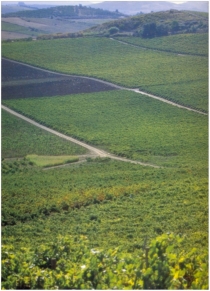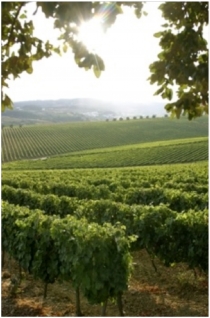Lisboa
Wine region: LISBOA
The creation of the Lisboa vitivinicultural region is the result of the balance achieved between the physical necessities of production and trade in the various regions, each of which has a great history in its own right. These concerted efforts brought about the institutional restructuring of the vitivinicultural sector and led to the establishment in 2008 of the COMISSÃO VITIVINÍCOLA DA REGIÃO DE LISBOA (“VITIVINICULTURAL COMMISSION OF THE LISBOA REGION”), abbreviated to CVRLx.
Since Antiquity, vines have been cultivated in the Lisboa area. There are traces of the Phoenicians, Greeks, Romans and Visigoths. During the Middles Ages, from the 12th century onwards there was a considerable increase in the number of religious orders, chief among them, the Cistercian Order in Alcobaça, where the followers of Saint Bernard dedicated themselves to viticulture. In addition to their ministerial duties, the Order gave work and professional training to Christian citizens. The wines formerly called “Estremadura” became widely consumed, gained much prestige, developed into one of the most important products in the economic activity of the region, and became identified with one of the best vitivinicultural regions of the country, both in terms of variety and wine production.
The relief is not very high, except in the south, where there are some strata of basalt and granite, and almost the entire region is covered in secondary clay‑limestone and sandy‑clay formations. It has a temperate climate without wide variations in temperature, and an annual rainfall of 600–700 mm.
The viticultural zones of the three Designations of Origin famous for their tradition and prestige are located in the southern area of the region: Bucelas, Carcavelos and Colares. To the north of the city of Lisbon is the region of “Bucelas”, where vineyards are planted in soils traditionally called “caeiras” derived predominantly from marls and hard limestones. The reference variety of the region is the Arinto. This is the only region which is designated a quality wine region for white wines only. To the west of Lisbon is the area where DOC “Carcavelos” is produced. This extraordinarily liqueur wine has been famous for many years, but today is something of a rarity. “Colares” is nestled in the Sintra mountains and because of its geological features is divided into two sub‑zones. “chão de areia”, literally “sandy ground” (an area of sandy dunes), and “chão rijo”, literally “hard ground” (calcareous brown soils made up of marl and similar material). The unique characteristics of the wine come from a combination of the soil, the maritime climate and the reference grapevine varieties, Tinto Ramisco and Branco Malvásia. The tradition is to plant vines “pé franco”, or ungrafted, deep in the soil below a layer of sand.
The central Estremadura comprises the Designation of Origin regions of “Alenquer”, “Arruda”, “Torres Vedras” and “Óbidos”.Situated close to the sea, it is worth noting this producer area is particularly devoted to the production of quality aguardentes, which deserve the exclusive recognition bestowed upon them by the “Lourinhã” Designation of Origin.
The “Encostas D’Aire” Designation of Origin is found further north, with its two subregions, “Alcobaça” and “Ourém”. In addition to the Lisboa IG or Lisboa regional designations for red, white, rosé, sparkling and liqueur wines, “Light Wine” may also be produced, a product low in alcohol and its own very particular characteristics.
(Translated from a quotation taken almost in its entirety from the IVV Yearbook.)
Types of vitivinicultural products
Lisboa IG wine or Lisboa regional wine (with the Estremadura and Alta Estremadura subregions): Red, white, rosé, sparkling, liqueur, light wine.
Alenquer DO, Arruda DO, Colares DO and Torres Vedras DO wines (VQPRD): Red and white, Bucelas DO wines: White and sparkling, Carcavelos DO wines (VLQPRD): Red liqueur and white liqueur, Óbidos DO wines: Red, white, rosé and sparkling, Encostas D’Aire DO wines (VQPRD): Red, white, rosé and”Medieval de Ourém”, Lourinhã DO wines: Aguardente Vínica (brandy from wine spirit).
Regional Contacts
Technical information: COMISSÃO VITIVINÍCOLA DA REGIÃO DE LISBOA (“VITIVINICULTURAL COMMISSION OF THE LISBOA REGION”) rua Cândido dos Reis Apartado 145, 2564‑910 Torres Vedras. Tel 261316724, e‑mail: CVR.Lisboa@mail.telepac.pt, Website: www.vinhosdaestremadura.pt
Cultural information on the wine of the region: Confraria das Enófilos da Estremadura, Citarão (“Oenophilists’ Society of the Estremadura, Citarão”) – EN 8, Apartado 69, 2544‑909 Bombarral. Museu Nacional do Vinho, Rua de Leiria Olival Fechado , 2460‑059 Alcobaça, Tel. 213 506 700.
Institutions of higher learning and viticultural research: Instituto Superior de Agronomia, ISA (“Higher Institute of Agronomy, ISA”), Tapada da Ajuda, 1349 – 017 Lisbon; Website: www.isa.utl.pt.
Certification authority:COMISSÃO VITIVINÍCOLA DA REGIÃO DE LISBOA (“VITIVINICULTURAL COMMISSION OF THE LISBOA REGION”) 2560‑312 TORRES VEDRAS, Rua Cândido dos Reis – Apartado 145, Fax: 261 313 541 Tel.: 261 316 724 – Website: www.vinhosdaestremadura.pt, e‑mail: cvr.lisboa@mail.telepac.pt
Eno‑tourism information: Rota da vinha e do vinho – região de tourismo do Oeste (“Wine and Vine Route – Oeste tourism region”), Rua Direita, 2510 Obidos, Tel 262955060; Site: www.rotavinhooeste.com


Producer and bottler information on wine from the Lisboa region http://www.ivv.min‑agricultura.pt/np4/1736.html, → Yearbook 2011, pages 200‑205.
Official designations: IGP Lisboa, Regional wine

Legislation: Ministerial Directive No. 426/2009, Decree‑Law No. 212/2004 and Reg. (EC) No. 1234/2007, (as amended by Reg. (EC) No. 491/2009).
(For DOP wines, there are binding correlations between varieties. Please speak with CVR or visit the IVV yearbook on the Internet before planting.)
RED WINES: Alfrocheiro, Alicante Bouschet, Amostrinha, Aragonez (Tinta Roriz), Baga, Bastardo, Bonvedro, Cabernet Franc, Cabernet Sauvignon, Caladoc, Camarate, Carignan, Castelão, Cinsaut, Grand Noir, Grenache, Grossa, Jaen, Merlot, Moreto, Negra Mole, Parreira Matias, Petit Verdot, Pinot Noir, Preto Martinho, Ramisco, Rufete, Syrah, Tinta Barroca, Tinta Caiada, Tinta Carvalha, Tinta Miúda, Tintinha, Tinto Cão, Touriga Franca, Touriga Nacional, Trincadeira (Tinta Amarela), Cabinda, Molar, Monvedro, Preto Cardana, Sousão, Tannat, Tinta Lisboa, Tinta Pomar, Valbom, Zinfandel, Fernão‑Pires Rosado®, Gewurztraminer®, and Pinot Gris®.
WHITE WINES: Alicante Branco, Almafra, Alvarinho, Antão Vaz, Arinto (Pedernã), Bical, Boal Branco, Boal Espinho, Cerceal Branco, Chardonnay, Diagalves, Fernão Pires (Maria Gomes), Galego Dourado, Jampal, Malvasia, Malvasia Rei, Moscatel Graúdo, Rabo de Ovelha, Riesling, Sauvignon, Seara Nova, Sercial (Esgana Cão), Síria (Roupeiro), Tália, Tamarez, Trincadeira Branca, Trincadeira das Pratas, Viognier, Viosinho, Vital, Alvadurão, Cercial, Chenin, Encruzado, Loureiro, Malvasia‑Fina, Marquinhas, Pinot‑Blanc, Ratinho, Semillon and Verdelho.
Designation: DO (subregion) Alta‑Estremadura
RED WINES: Alfrocheiro, Alicante Bouschet, Amostrinha, Aragonez (Tinta Roriz), Baga, Bastardo, Cabernet Franc, Cabernet Sauvignon, Caladoc, Camarate, Carignan, Castelão (Periquita), Cinsaut, Grand Noir, Grenache, Grossa, Jaen, Merlot, Moreto, Negra Mole, Pinot Noir, Rufete, Syrah, Tinta Carvalha, Tinta Miúda, Tintinha, Tinto Cão, Touriga Franca, Touriga Nacional, Trincadeira (Tinta Amarela), Parreira Matias, Petit Verdot, Sousão, Tinta‑Barroca, Tinta‑Caiada, Tinta Lisboa, Zinfandel and Gewurztraminer
WHITE WINES: Alicante Branco, Almafra, Alvarinho, Antão Vaz, Arinto (Pedernã), Bical, Boal Branco, Boal Espinho, Cerceal Branco, Chardonnay, Diagalves, Fernão Pires (Maria Gomes), Galego Dourado, Jampal, Malvasia, Malvasia Rei, Moscatel Graúdo, Rabo de Ovelha, Riesling, Sauvignon, Seara Nova, Sercial (Esgana Cão), Síria (Roupeiro), Tália, Tamarez, Trincadeira Branca, Trincadeira das Pratas, Viognier, Viosinho, Vital, Alvadurão, Cercial, Chenin, Encruzado, Loureiro, Malvasia‑Fina, Marquinhas, Pinot‑Blanc, Ratinho, Semillon and Verdelho
The Lisboa region covers the following DOP designations:
Designation: DO “Encostas D’Aire” VQPRD
![]()
Legislation:Ministerial Directive No. 167/2005 dated 11 February and Reg. (EC) 1493/99.
Varieties:
RED WINES: Aragonez (Tinta Roriz), Baga, Castelão, Tinta Miúda, Touriga Nacional and Trincadeira (Tinta Amarela), together or separately containing at least 65% of the specified grapevine variety or varieties, Alicante Bouchet, Caladoc, Grand Noir and Syrah, Alfrocheiro, Amostrinha, Bastardo, Cabernet Sauvignon, Rufete and Touriga Franca
WHITE WINES: Arinto (Pedernã), Fernão Pires (Maria Gomes), Ratinho, Seara Nova, Tamarez and Vital, together or separately containing at least 65% of the specified grapevine variety or varieties, Alicante Branco, Bical, Boal Branco, Cercial, Chardonnay, Diagalves, Jampal, Malvasia Fina, Rabo de Ovelha and Trincadeira Branca.
Covers two subregions
(Subregion) ”Alcobaça”
Varieties:
RED WINES: Aragonez (Tinta Roriz), Baga, Castelão, Tinta Miúda, and Touriga Nacional Alicante Bouschet, Syrah, Amostrinha, Rufete and Touriga Franca.
WHITE WINES: Fernão Pires (Maria Gomes), Ratinho, Tamarez and Vital, Bical, Cercial, Chardonnay, Rabo de Ovelha and Trincadeira Branca
“Ourém” subregion
Varieties:
RED WINES: Trincadeira (Tinta Amarela)
WHITE WINES: Fernão Pires (Maria Gomes)
Designation: “Óbidos” DO VQPRD
Legislation:Decree‑Law No. 212/2004, Ministerial Directive No. 816/2006, Reg. (EC) 1493/99.
Varieties:
RED WINES: Alicante Bouschet, Amostrinha, Aragonez (Tinta Roriz), Baga, Cabernet Sauvignon, Caladoc, Camarate, Carignan, Castelão, Jaen, Merlot, Pinot Noir, Preto Martinho, Syrah, Tinta Barroca, Tinta Miúda, Touriga Franca, Touriga Nacional and Trincadeira (Tinta Amarela)
WHITE WINES: Alicante Branco, Alvarinho, Antão Vaz, Arinto (Pedernã), Chardonnay, Encruzado, Fernão Pires (Maria Gomes), Jampal, Loureiro, Malvasia Rei, Moscatel Graúdo, Rabo de Ovelha, Ratinho, Riesling, Sauvignon, Seara Nova, Verdelho, Viognier, Viosinho and Vital
Designation: DOP “Alenquer” VQPRD
![]()
Legislation: Decree‑Law No. 375/93, Decree‑Law No. 116/99, Decree‑Law No. 219/2002 and Reg. (EC) No. 1493/99).
Varieties:
RED WINES: Aragonez (Tinta Roriz), Castelão (Periquita), Tinta Miúda, Touriga Nacional e Trincadeira (Tinta Amarela), together or separately containing at least 65% of the specified grapevine variety or varieties, Alicante Bouschet, Amostrinha, Baga, Cabernet Sauvignon, Caladoc, Camarate, Jaen, Preto Martinho, Syrah, Tinta Barroca and Touriga Franca.
WHITE WINES: Arinto (Pedernã), Fernão Pires (Maria Gomes), Rabo de Ovelha, Seara Nova, and Vital. Alicante Branco, Alvarinho, Chardonnay, Jampal, Malvasia Rei, Ratinho, Sauvignon and Viosinho.
Designation: DOP “Arruda” VQPRD

Legislation:Decree‑Law No. 375/93, Decree‑Law No. 116/99, Decree‑Law No. 219/2002 and Reg. (EC) No. 1493/99).
Varieties:
RED WINES: Aragonez (Tinta Roriz), Castelão (Periquita), Tinta Miúda, Touriga Nacional e Trincadeira (Tinta Amarela), together or separately containing at least 70% of the specified grapevine variety or varieties, Caladoc Alicante Bouschet, Cabernet Sauvignon, Camarate, Jaen, Syrah, Tinta Barroca and Touriga Franca.
WHITE WINES: Arinto (Pedernã), Fernão Pires (Maria Gomes), Rabo de Ovelha, Seara Nova e Vital, Alicante Branco, Chardonnay, Jampal, Malvasia Rei, Sauvignon and Viosinho.
Designation: DOP “Torres Vedras” VQPRD

Legislation: Decree‑Law No. 375/93, Decree‑Law No. 116/99, Decree‑Law No. 219/2002 and Reg. (EC) No. 1493/99).
Varieties:
RED WINES: Aragonez (Tinta Roriz), Castelão (Periquita), Tinta Miúda and Touriga Nacional, Caladosc, Trincadeira (Tinta Amarela, Alicante Bouschet.
Cabernet Sauvignon, Camarate, Jaen, Syrah, Tinta Barroca and Touriga Franca.
WHITE WINES: Arinto (Pedernã), Fernão Pires (Maria Gomes), Rabo de Ovelha, Seara Nova, e Vital, together or separately containing at least 70% of the specified grapevine variety or varieties, Alicante Branco, Alvarinho, Antão Vaz, Chardonnay, Malvasia Rei, Sauvignon and Viosinho.
Designation: DOP “Lourinhã” DOP brandy (from wine spirit)
Legislation: Decree‑Law No. 34/92, Decree Law No. 323/94, Reg. (EC) 1493/99.
Varieties:
RED WINES: Cabinda
WHITE WINES: Alicante Branco, Alvadurão, Boal Espinho, Marquinhas, Malvasia Rei and Tália.
Designation: DOP “Bucelas” VQPRD
![]()
Legislation: Decree‑Law No. 43/2000, Reg. (EC) 1493/99.
Varieties:
WHITE WINES: Arinto (Pedernã), Sercial (Esgana Cão) and Rabo de Ovelha.
Designation: DOP “Carcavelos” VLQPRD
![]()
Legislation: Decree‑Law No. 246/94, Reg. (EC) 1493/99.
Varieties:
RED WINES: Castelão (Periquita) and Preto Martinho,
WHITE WINES: Galego Dourado, Ratinho and Arinto (Pedernã).
Designation: DOP “Colares” VQPRD (in sandy soil)

Legislation: Decree‑Law No. 246/94 dated 29 September and Reg. (EC) 1493/99 dated 17 May.
Varieties:
RED WINES: Ramisco
WHITE WINES: Malvasia




